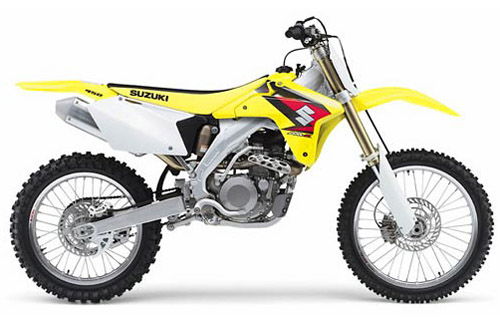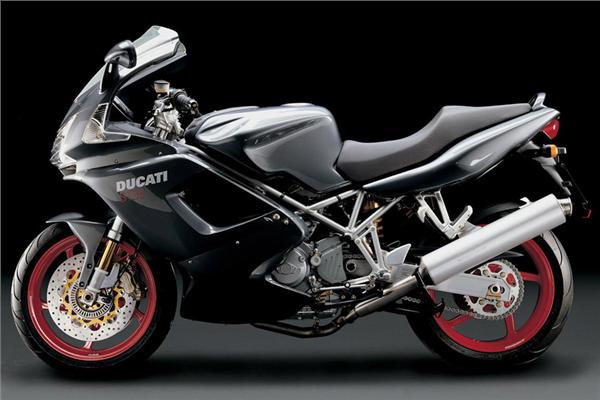404 DS Trail (2003 - present) review
Niall Mackenzie rides CCM's 404 DS.

Niall Mackenzie rides CCM's 404 DS.
Our Niall has a bit of history with off-road specialists CCM - they gave him a break into racing, and he's owned one of their bikes. Before they knew it he was riding their new 404DS
I must always be careful when evaluating CCMs as I could so easily be biased towards every bike they produce. You see, during the 1980s CCM were taken over by the Armstrong Shock Absorber Company and became Armstrong Motorcycles. In 1983 they kindly plucked me from obscurity and for four years allowed me to hone my racing skills on their carbon fibre racers. After winning four British Championships, I jumped ship to HRC in 1987 and soon after they reverted back to their original name and off-road roots. Backed with venture capital cash they moved from Bury to a fresh new factory in Blackburn where production is steadily increasing and a factory expansion is planned in the near future.
Thinking I was paying them back in some small way I actually bought a 640cc Rotax engined CCM in 1999 believing I could take on my mates with Japanese equivalents. I was wrong. It was heavy with not such good suspension and it scared me, so she had to go.
Trax in Preston was the venue for the new 404 launch and it was the DS model, that comes in supermoto and trail form, that I was testing. I was hoping to find that this Suzuki DR-Z-engined model would agree with me more than my Rotax powered brute ever did.
First up was the supermoto version and a tentative venture on to the damp tarmac with everyone watching as I was first out. Immediately I realised I had two options: look average and enjoy the rest of the day or look spectacular and enjoy the rest of the day at Preston Royal. My insurance benefits are much less attractive these days so I chose option one, gradually building up speed as the track dried.
I couldn't get a lot of feel from the standard fit Pirelli MT60s, however I had no big moments as the circuit became dry. I thrashed round and round on the clockwise circuit side with no sign of overheating or tearing. Throttle response was super smooth especially off the bottom with a closed throttle which greatly helped a supermoto amateur like me. A bit more oomph further up the powerband would have been nice as top end power felt quite flat. This might have gone unnoticed but CCM factory supermoto rider Stephan Mezard let me loose on his steed which has twenty more bhp. It also has beefed up brakes and suspension but strangely made no difference to my lap time.
Back to the standard bike and I found it had very light handling with good stability through the tight chicane and slow corners. The 404DS is fitted with the best WP suspension available and although standard settings felt a bit soft it never did anything untoward. The Brembo brakes had good feel with consistent performance and were more than adequate for my ability. Overall I found the DS Supermoto a very capable tool that looks good with all the quality bits bolted on as standard. It could happily take you to work midweek then with a few tweaks have you competing at the weekend - if you were to feel that way inclined. The choice is yours.
So a quick drink to wash down some Lancashire hot pot and it was on to the 404 DS Trail. 15 minutes is all it takes to transform your supermoto into a top trail bike. This mainly involves a change of wheels mounted with Pirelli MT21 tyres.
The varied off-road course consisted of whoops, sand dunes and some fast gravel roads. None of these proved a big problem for the DS although both high and low speed stability didn't feel as good as DR-Z Suzukis I've ridden at the Mallory Park off-road centre recently. The high speed stuff was cured with pulling harder on the bars but I felt that you sat higher and less over the front compared to the DR-Z, which gave me less control mid-corner. I must say, however, that I was never uncomfortable sitting down or standing up. In deep sand I found myself searching for gears, something I don't have to do on my 450 EXC. But that said, my KTM has more power than I can handle most of the time. All the bikes have a funky looking dash with multi function digital displays for enduro work with the usual switchgear on the bars.
Generally the bike has a quality look and feel but the most important test for me was that it passed with flying colours - I didn't want the day to end and I seldom stopped grinning. On my drive home I was pondering whether I could once again spend my own money on the best ever CCM. Why would it steer me away from the equally good and sometimes cheaper competition?
Verdict
I still haven't decided but there is a strong case for supporting the guys from Blackburn. Quality components come as standard. WP suspension, Brembo brakes, Magura bars, strong Japanese engine. For an extra £925 you can have the supermoto package which effectively gives you another bike. And finally, it's built in Britain by a dedicated team that is passionate about motorcycles, and that really can't be a bad thing.
EVOLUTION:
1971 - CCM founder Alan Clews builds first Clews Competition Machine (CCM) in his garage. The firm grows from here specialising in competition off-roaders, branching into road racers in association with Armstrong and taking a brace of British titles
2001 - R30 supermoto released as the company's first proper roadbike. It looks good, but ageing Rotax motor lets it down
2002 - R30 gets Suzuki DR-Z based motor and is miles better although still far from practical.
Niall Mackenzie rides CCM's 404 DS.
Our Niall has a bit of history with off-road specialists CCM - they gave him a break into racing, and he's owned one of their bikes. Before they knew it he was riding their new 404DS
I must always be careful when evaluating CCMs as I could so easily be biased towards every bike they produce. You see, during the 1980s CCM were taken over by the Armstrong Shock Absorber Company and became Armstrong Motorcycles. In 1983 they kindly plucked me from obscurity and for four years allowed me to hone my racing skills on their carbon fibre racers. After winning four British Championships, I jumped ship to HRC in 1987 and soon after they reverted back to their original name and off-road roots. Backed with venture capital cash they moved from Bury to a fresh new factory in Blackburn where production is steadily increasing and a factory expansion is planned in the near future.
Thinking I was paying them back in some small way I actually bought a 640cc Rotax engined CCM in 1999 believing I could take on my mates with Japanese equivalents. I was wrong. It was heavy with not such good suspension and it scared me, so she had to go.
Trax in Preston was the venue for the new 404 launch and it was the DS model, that comes in supermoto and trail form, that I was testing. I was hoping to find that this Suzuki DR-Z-engined model would agree with me more than my Rotax powered brute ever did.
First up was the supermoto version and a tentative venture on to the damp tarmac with everyone watching as I was first out. Immediately I realised I had two options: look average and enjoy the rest of the day or look spectacular and enjoy the rest of the day at Preston Royal. My insurance benefits are much less attractive these days so I chose option one, gradually building up speed as the track dried.
I couldn't get a lot of feel from the standard fit Pirelli MT60s, however I had no big moments as the circuit became dry. I thrashed round and round on the clockwise circuit side with no sign of overheating or tearing. Throttle response was super smooth especially off the bottom with a closed throttle which greatly helped a supermoto amateur like me. A bit more oomph further up the powerband would have been nice as top end power felt quite flat. This might have gone unnoticed but CCM factory supermoto rider Stephan Mezard let me loose on his steed which has twenty more bhp. It also has beefed up brakes and suspension but strangely made no difference to my lap time.
Back to the standard bike and I found it had very light handling with good stability through the tight chicane and slow corners. The 404DS is fitted with the best WP suspension available and although standard settings felt a bit soft it never did anything untoward. The Brembo brakes had good feel with consistent performance and were more than adequate for my ability. Overall I found the DS Supermoto a very capable tool that looks good with all the quality bits bolted on as standard. It could happily take you to work midweek then with a few tweaks have you competing at the weekend - if you were to feel that way inclined. The choice is yours.
So a quick drink to wash down some Lancashire hot pot and it was on to the 404 DS Trail. 15 minutes is all it takes to transform your supermoto into a top trail bike. This mainly involves a change of wheels mounted with Pirelli MT21 tyres.
The varied off-road course consisted of whoops, sand dunes and some fast gravel roads. None of these proved a big problem for the DS although both high and low speed stability didn't feel as good as DR-Z Suzukis I've ridden at the Mallory Park off-road centre recently. The high speed stuff was cured with pulling harder on the bars but I felt that you sat higher and less over the front compared to the DR-Z, which gave me less control mid-corner. I must say, however, that I was never uncomfortable sitting down or standing up. In deep sand I found myself searching for gears, something I don't have to do on my 450 EXC. But that said, my KTM has more power than I can handle most of the time. All the bikes have a funky looking dash with multi function digital displays for enduro work with the usual switchgear on the bars.
Generally the bike has a quality look and feel but the most important test for me was that it passed with flying colours - I didn't want the day to end and I seldom stopped grinning. On my drive home I was pondering whether I could once again spend my own money on the best ever CCM. Why would it steer me away from the equally good and sometimes cheaper competition?
Verdict
I still haven't decided but there is a strong case for supporting the guys from Blackburn. Quality components come as standard. WP suspension, Brembo brakes, Magura bars, strong Japanese engine. For an extra £925 you can have the supermoto package which effectively gives you another bike. And finally, it's built in Britain by a dedicated team that is passionate about motorcycles, and that really can't be a bad thing.
EVOLUTION:
1971 - CCM founder Alan Clews builds first Clews Competition Machine (CCM) in his garage. The firm grows from here specialising in competition off-roaders, branching into road racers in association with Armstrong and taking a brace of British titles
2001 - R30 supermoto released as the company's first proper roadbike. It looks good, but ageing Rotax motor lets it down
2002 - R30 gets Suzuki DR-Z based motor and is miles better although still far from practical.

